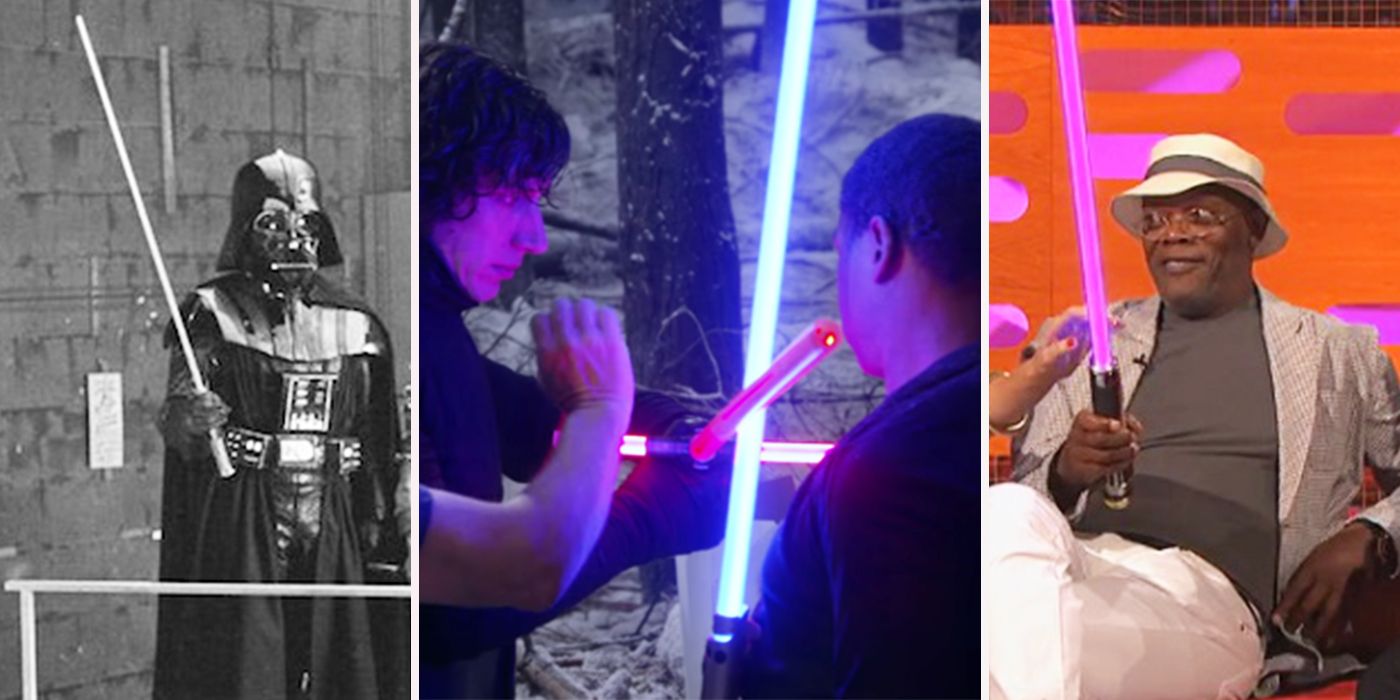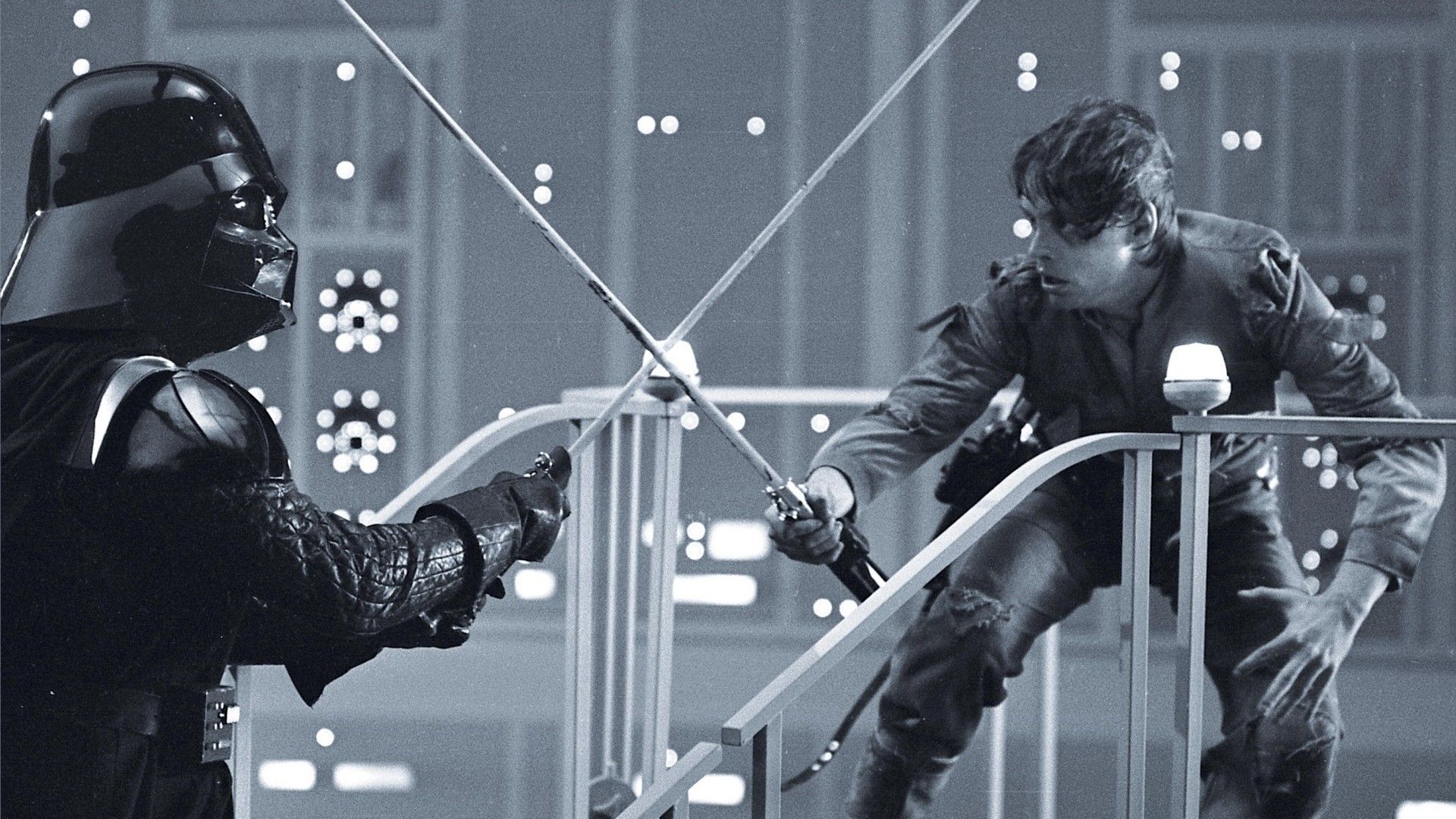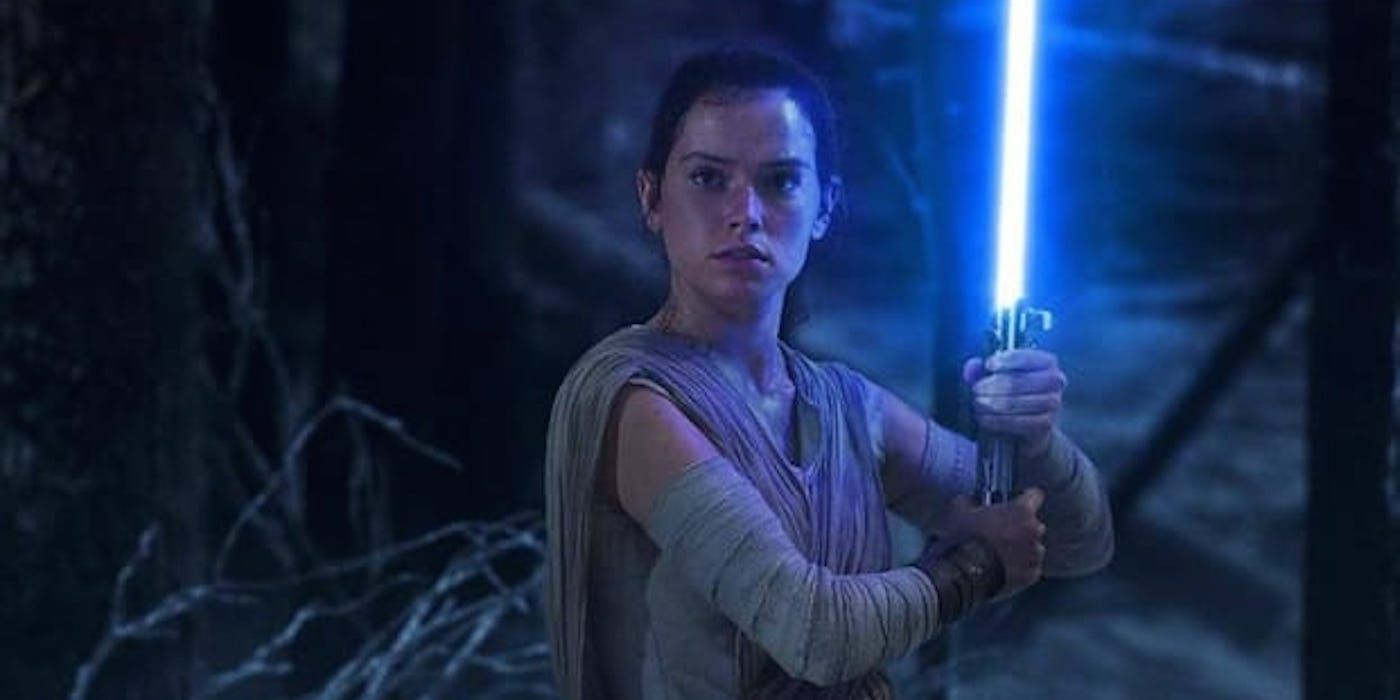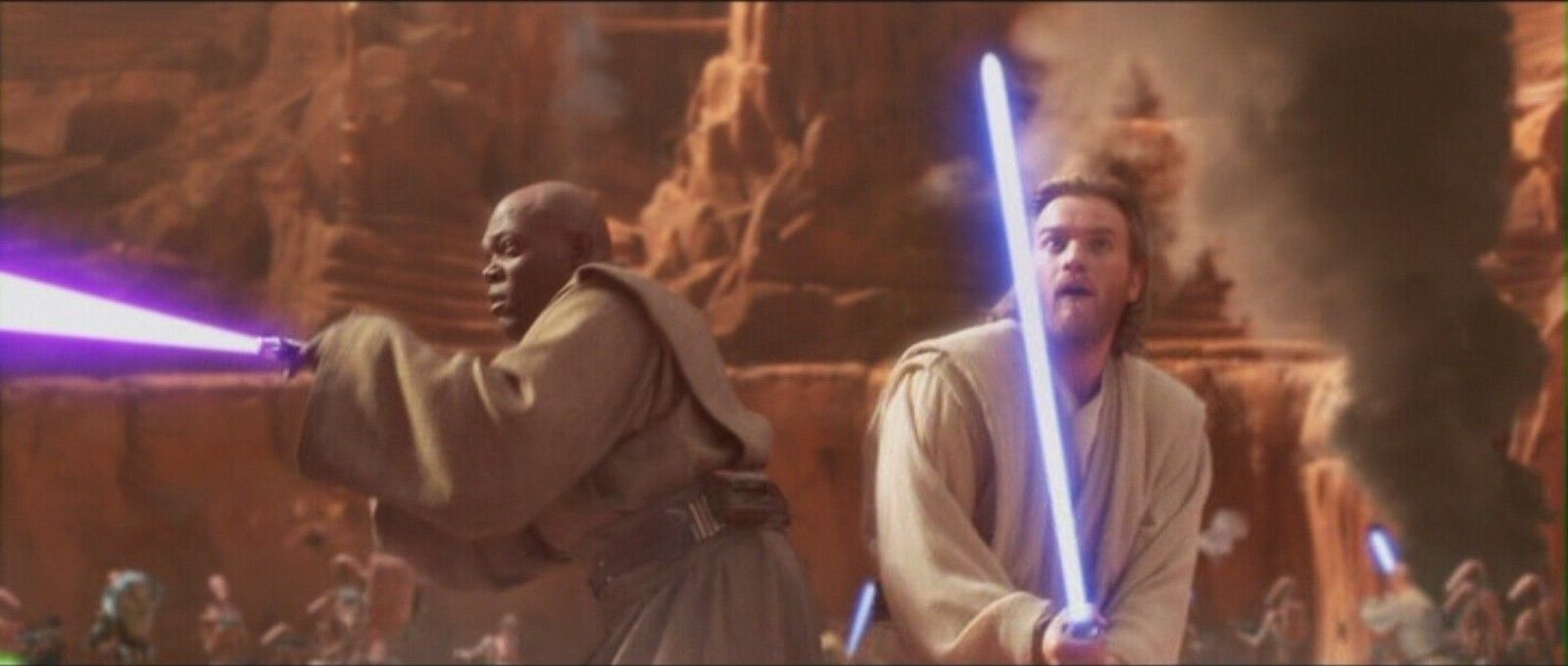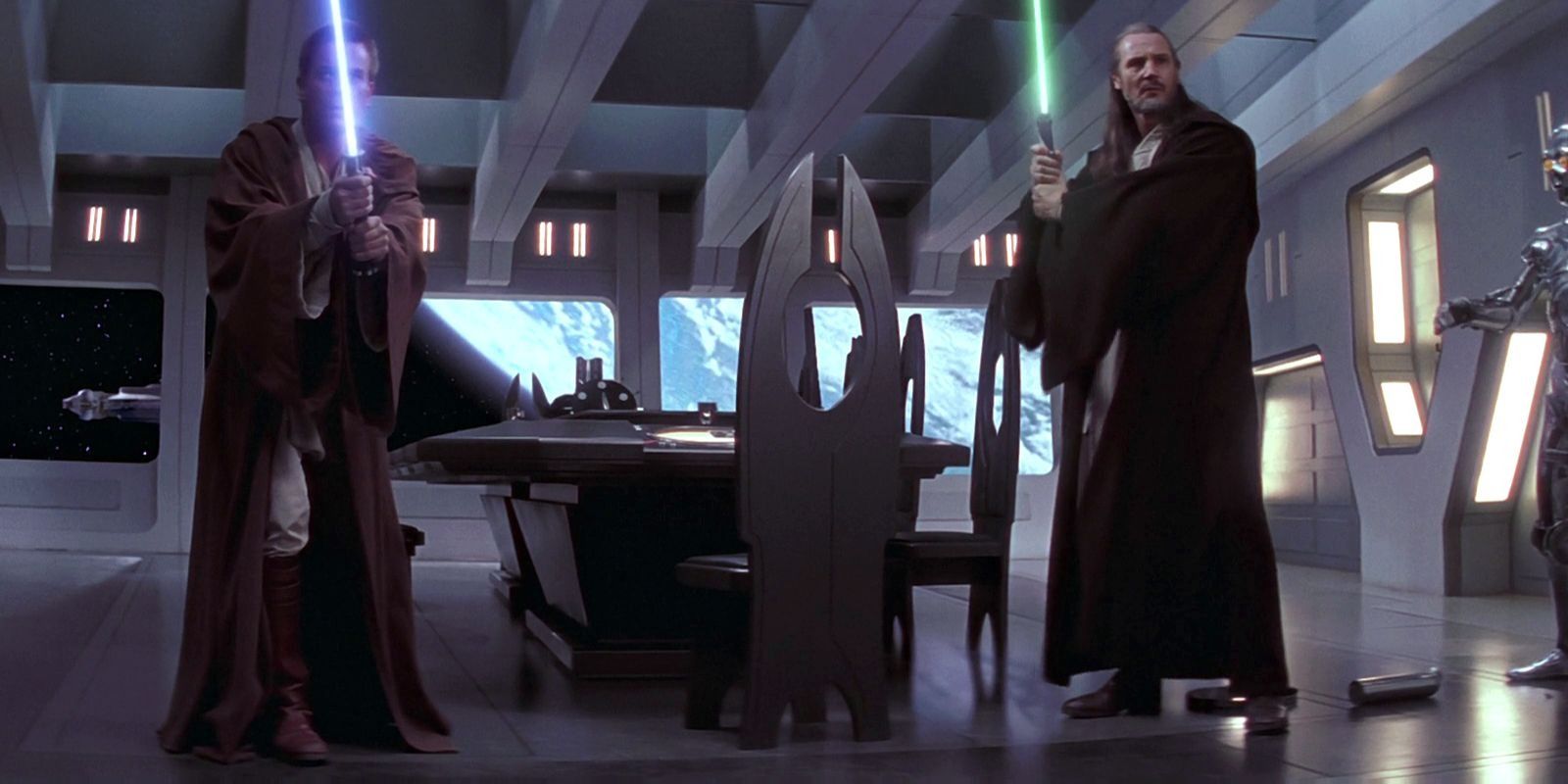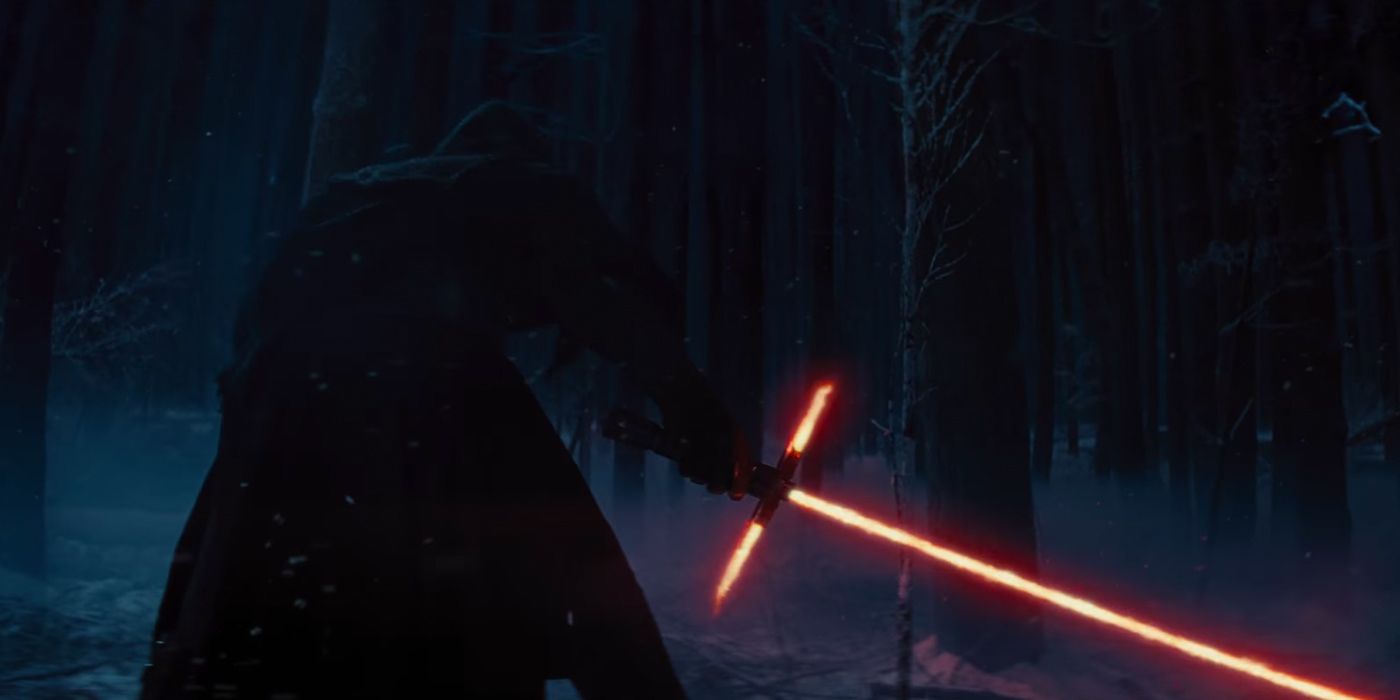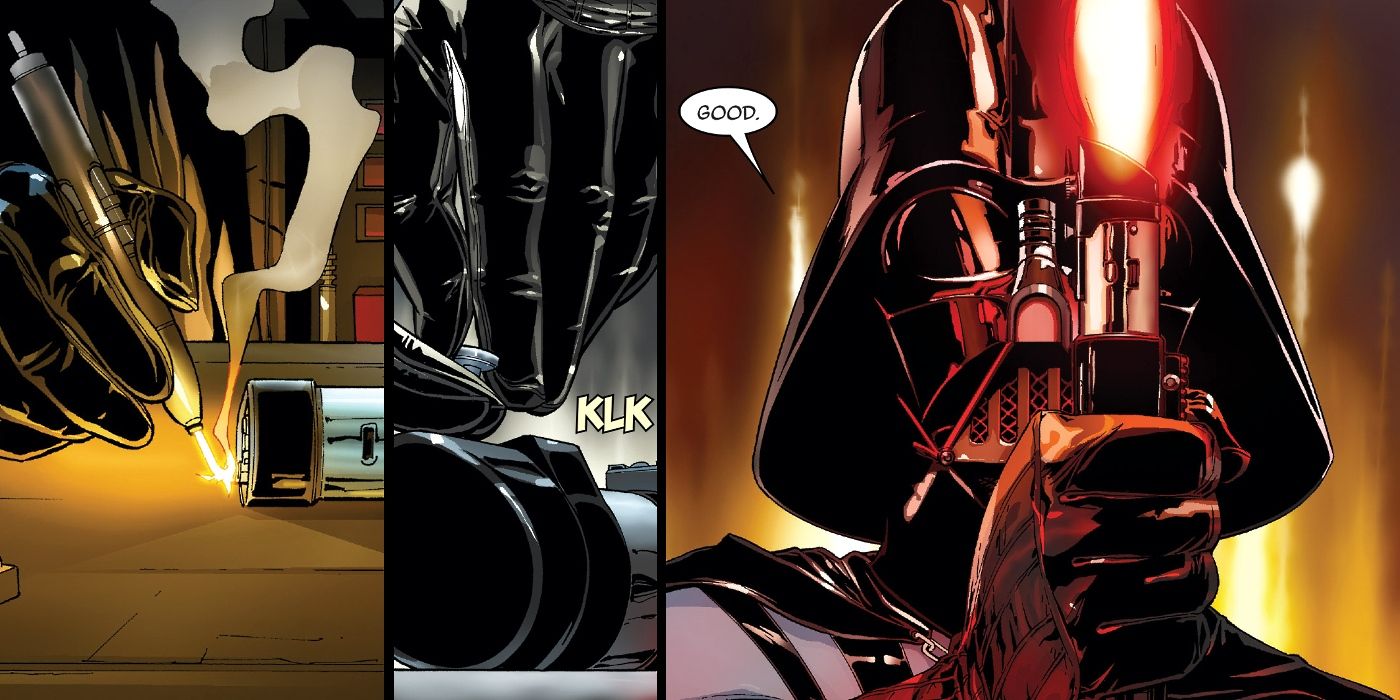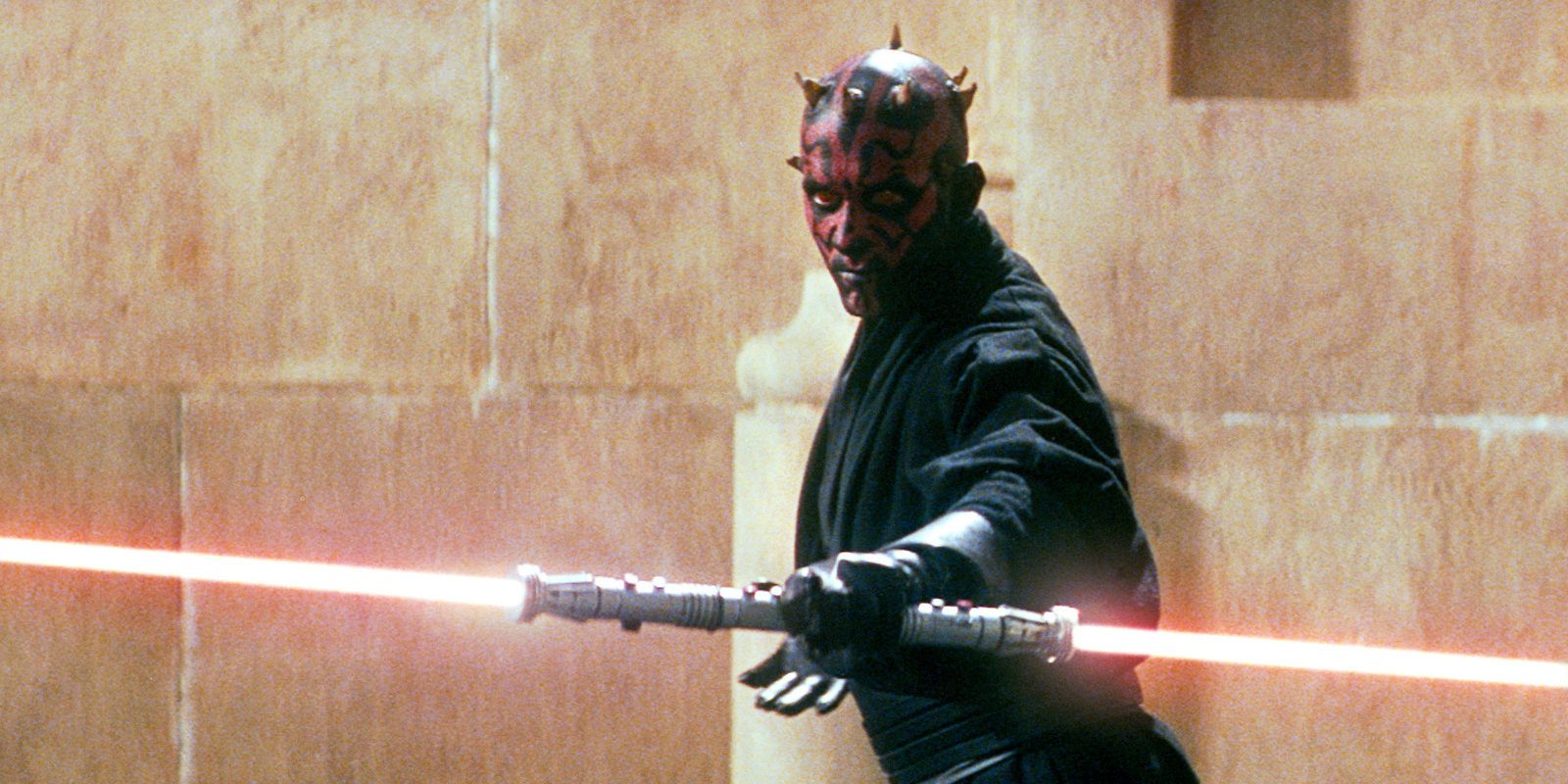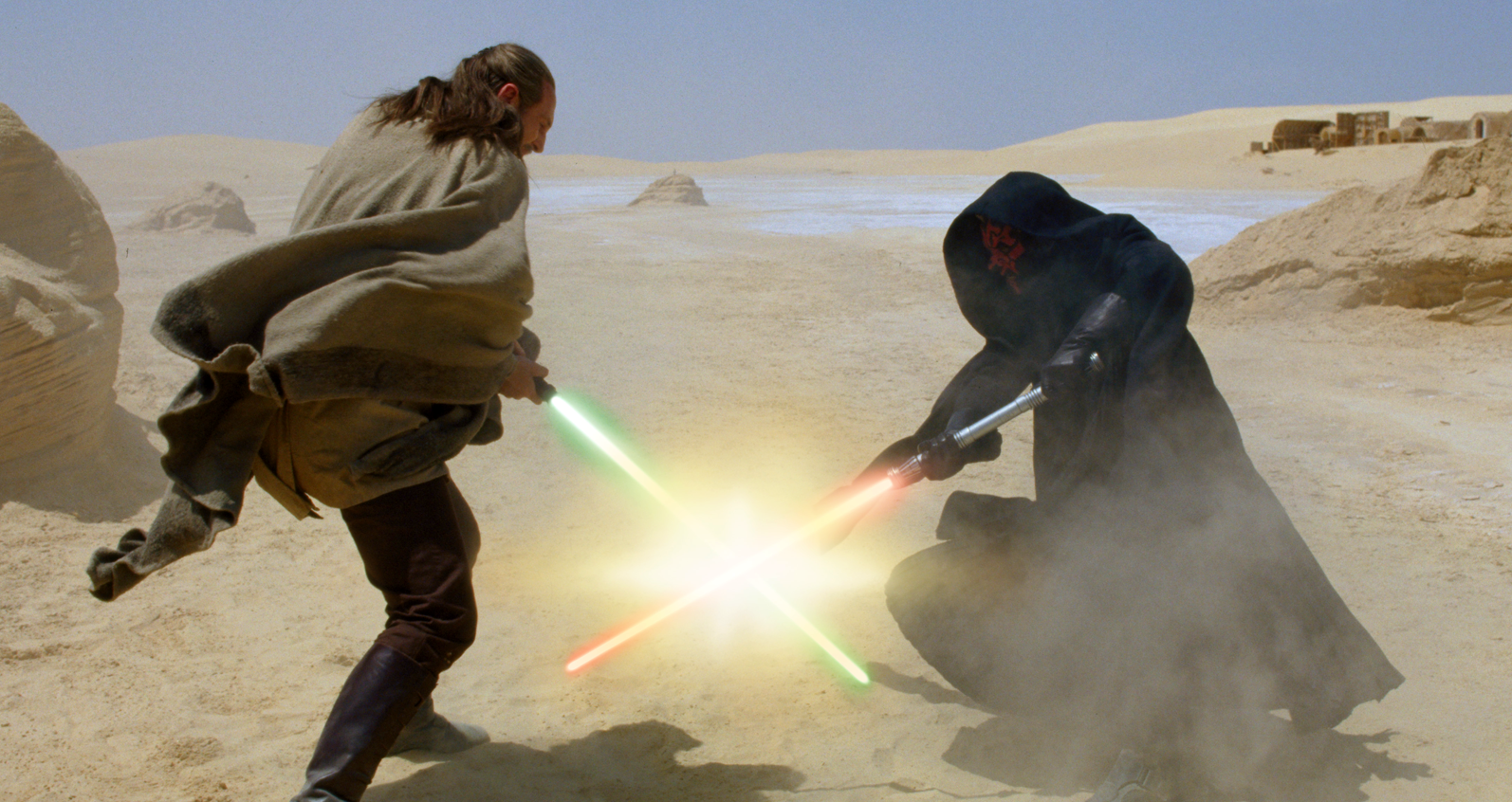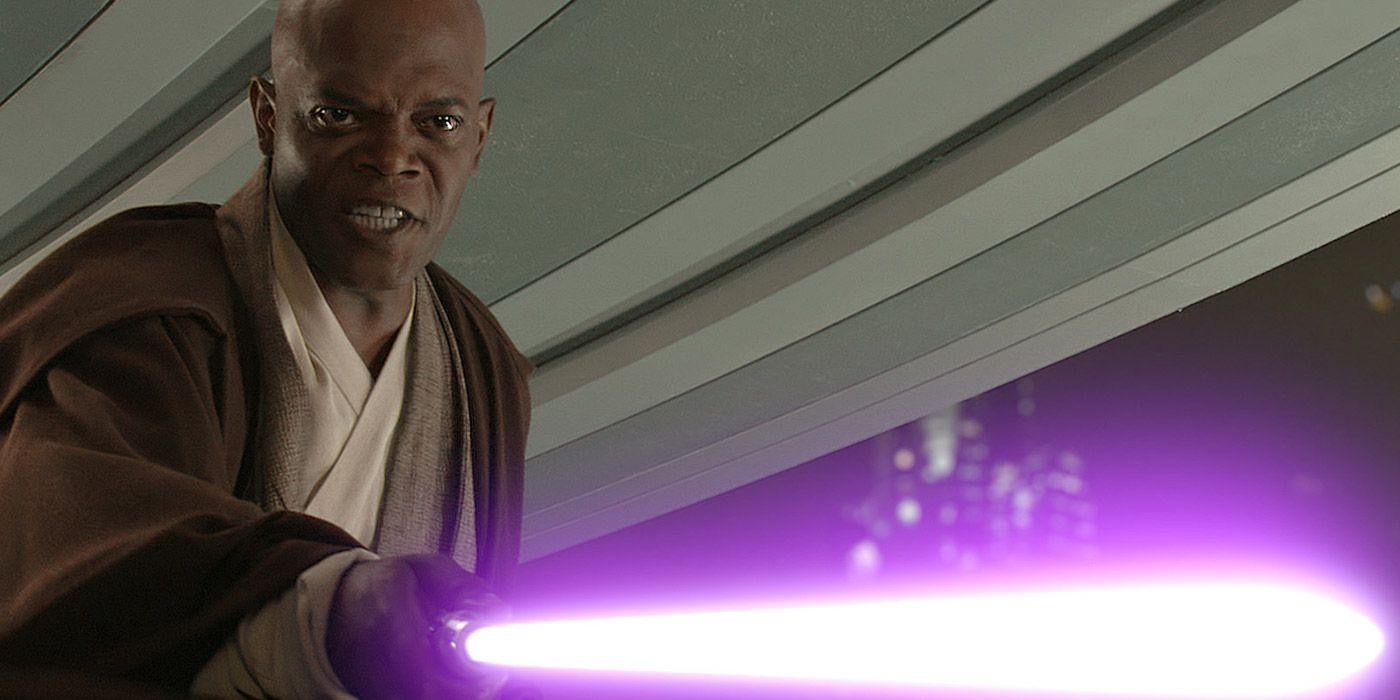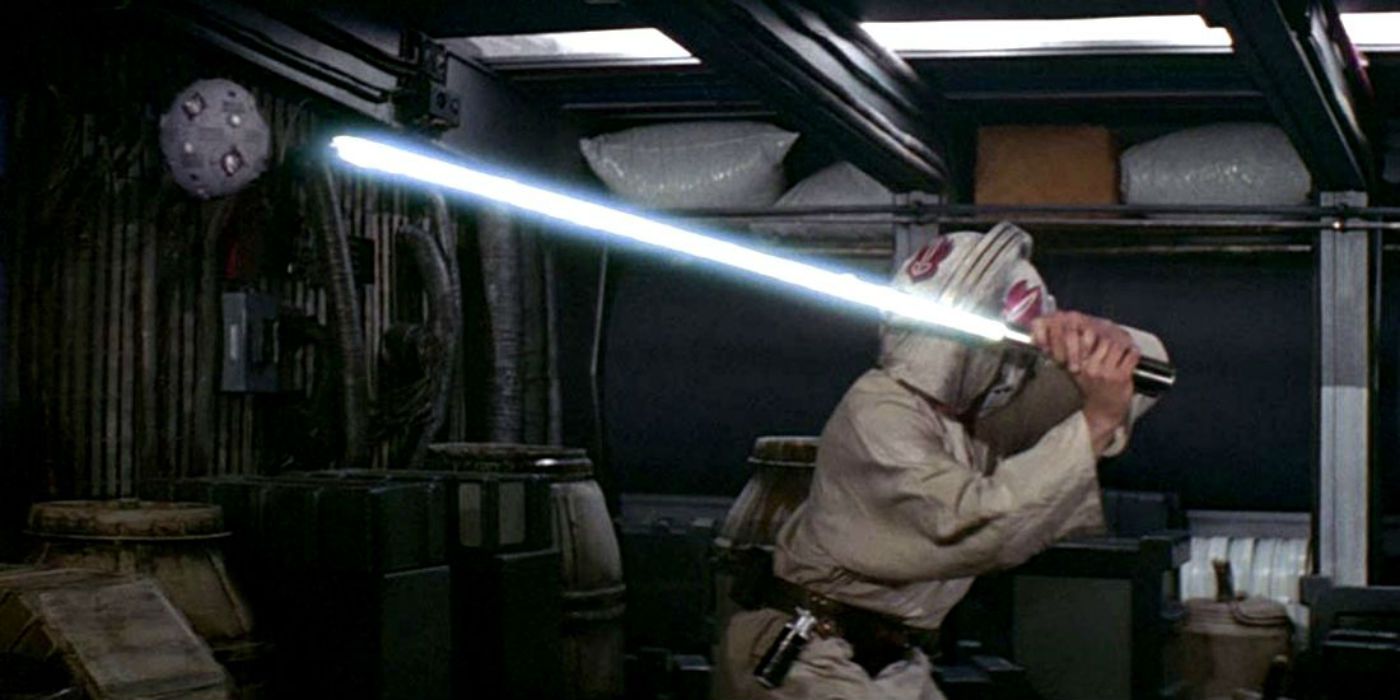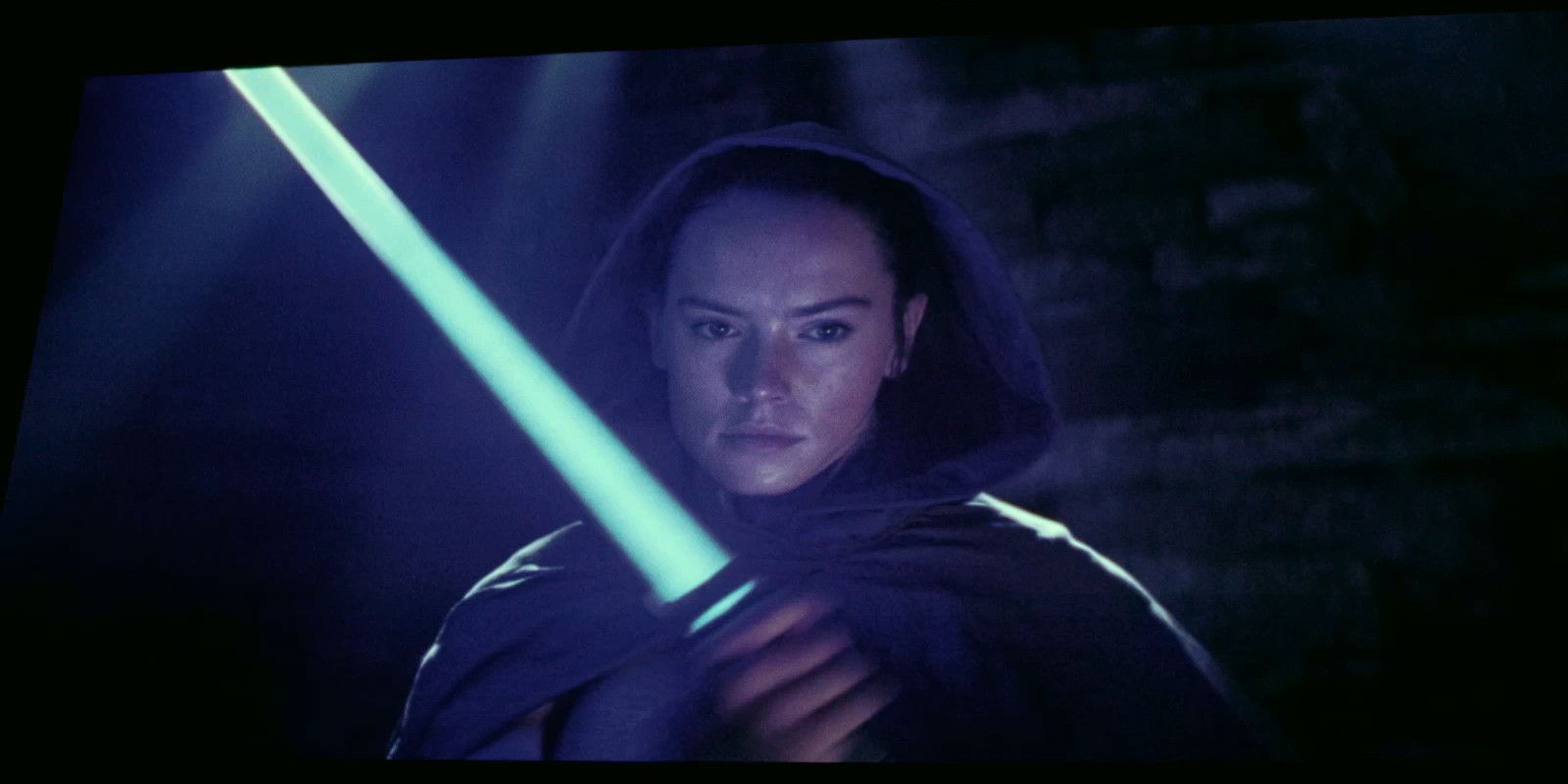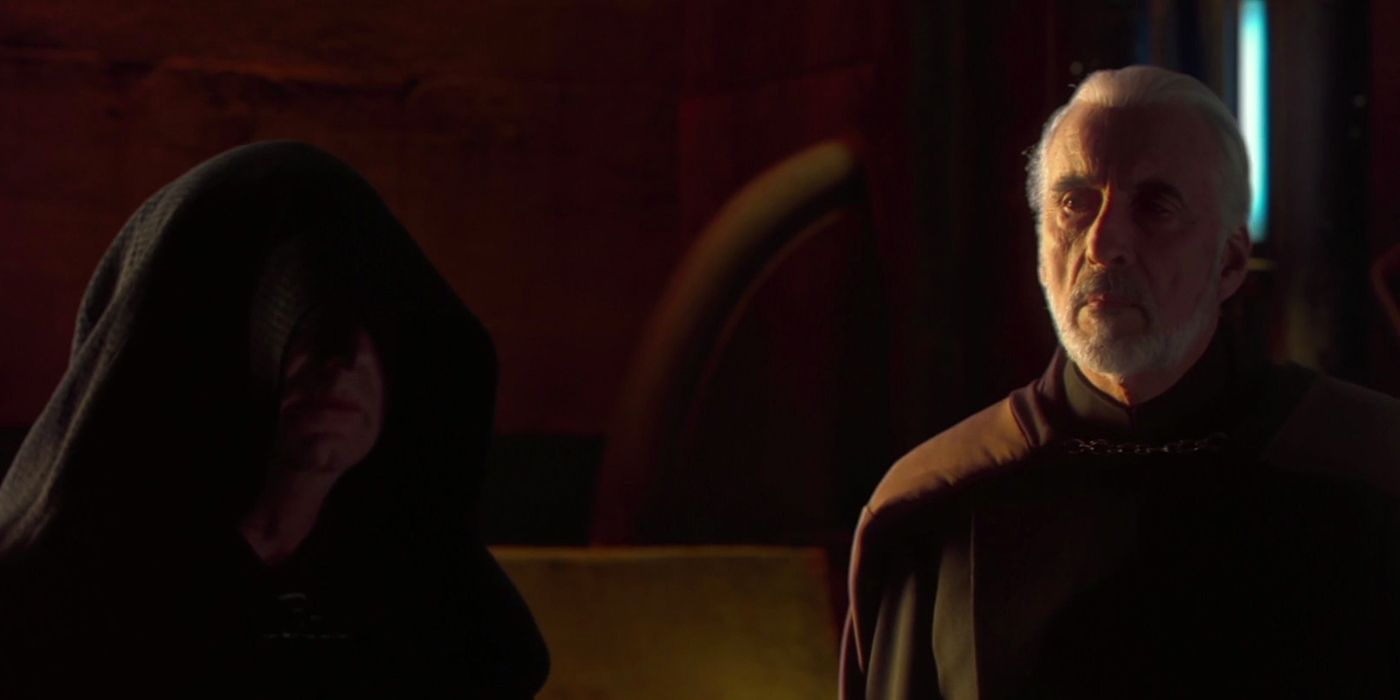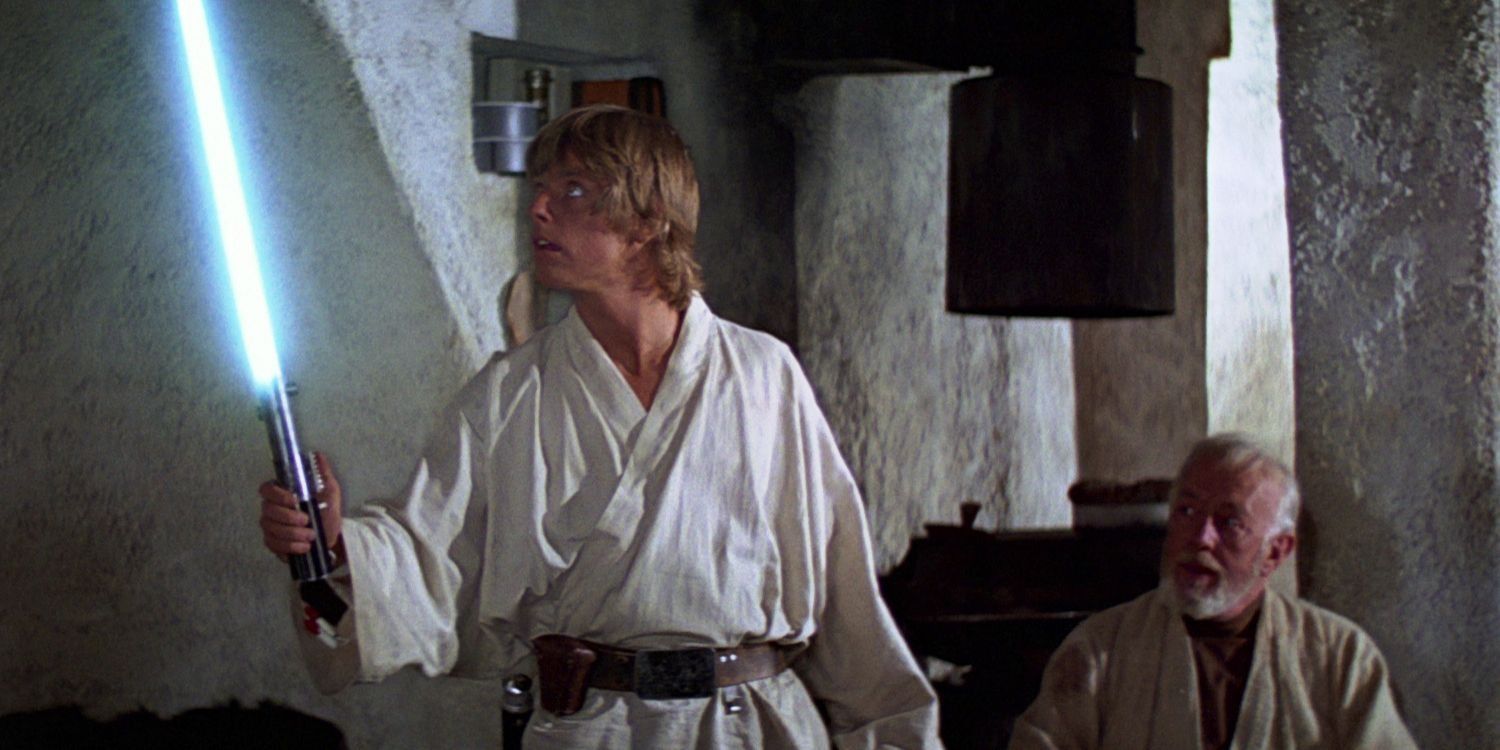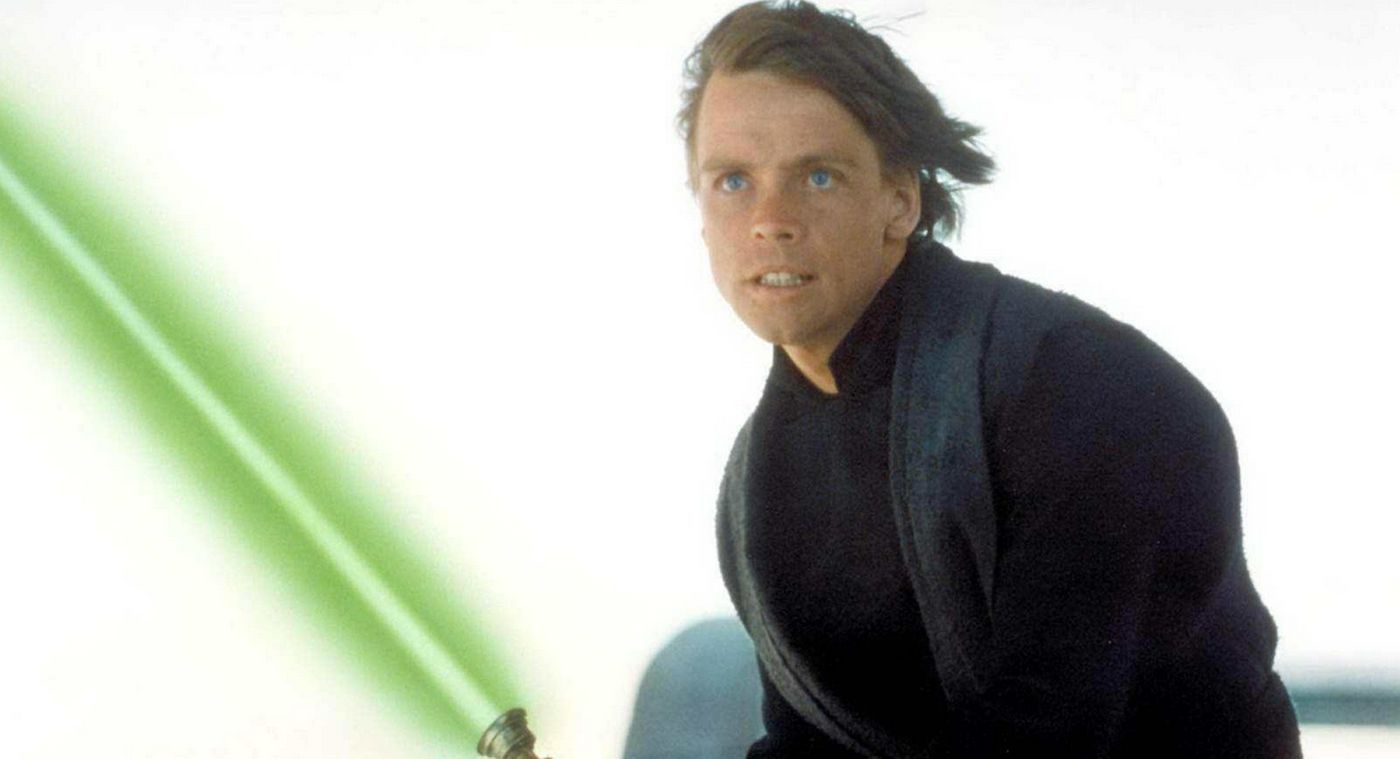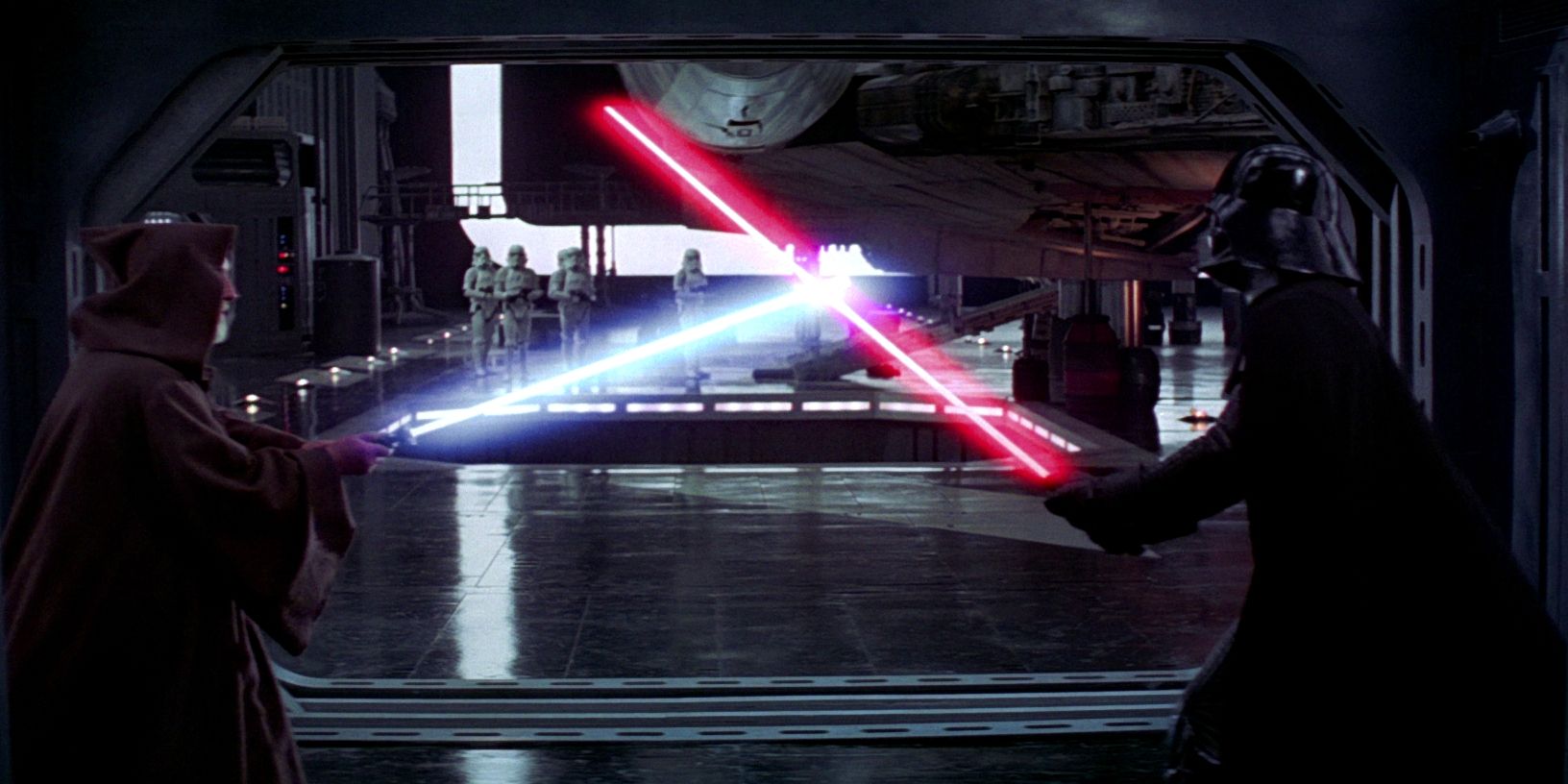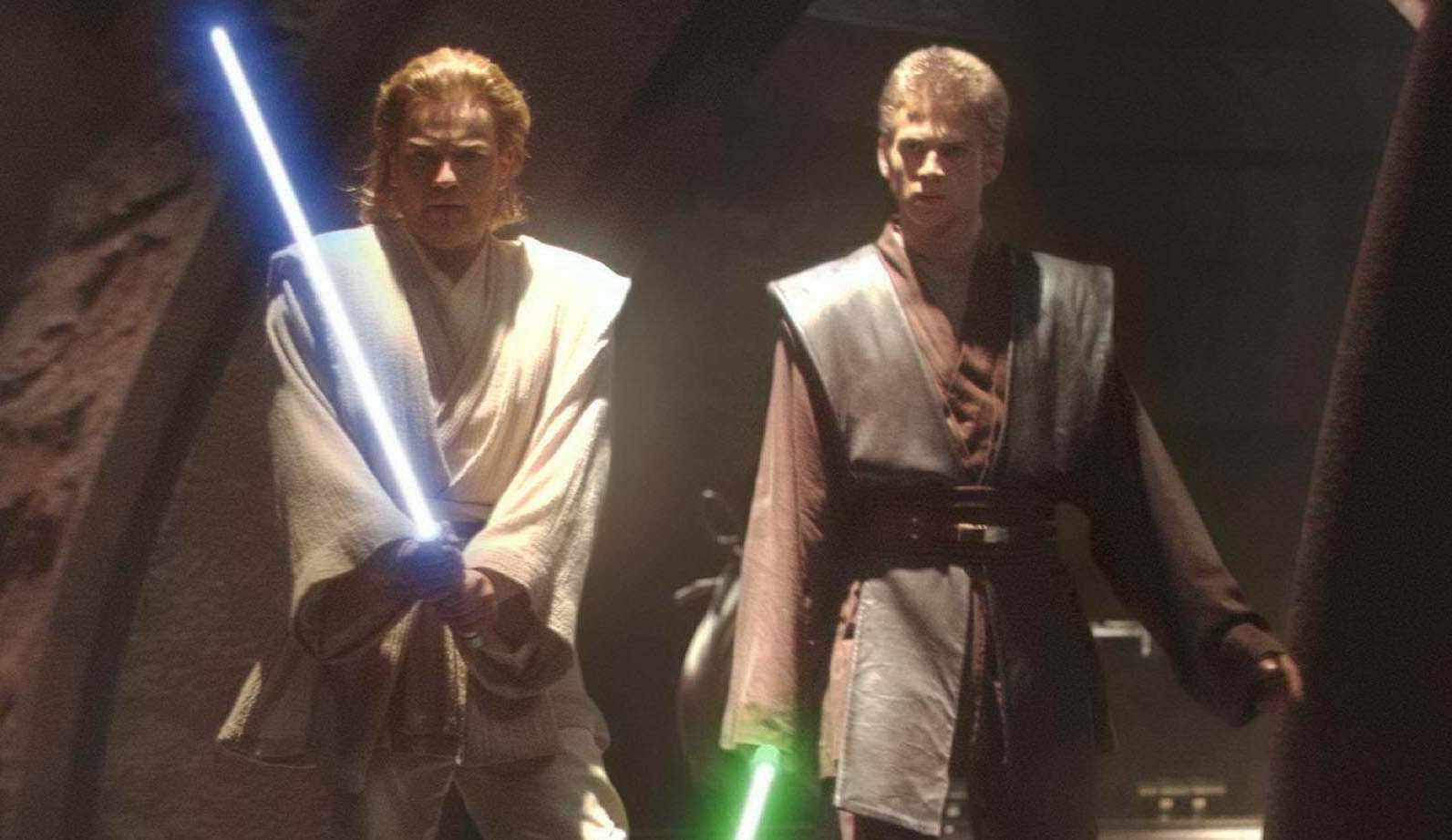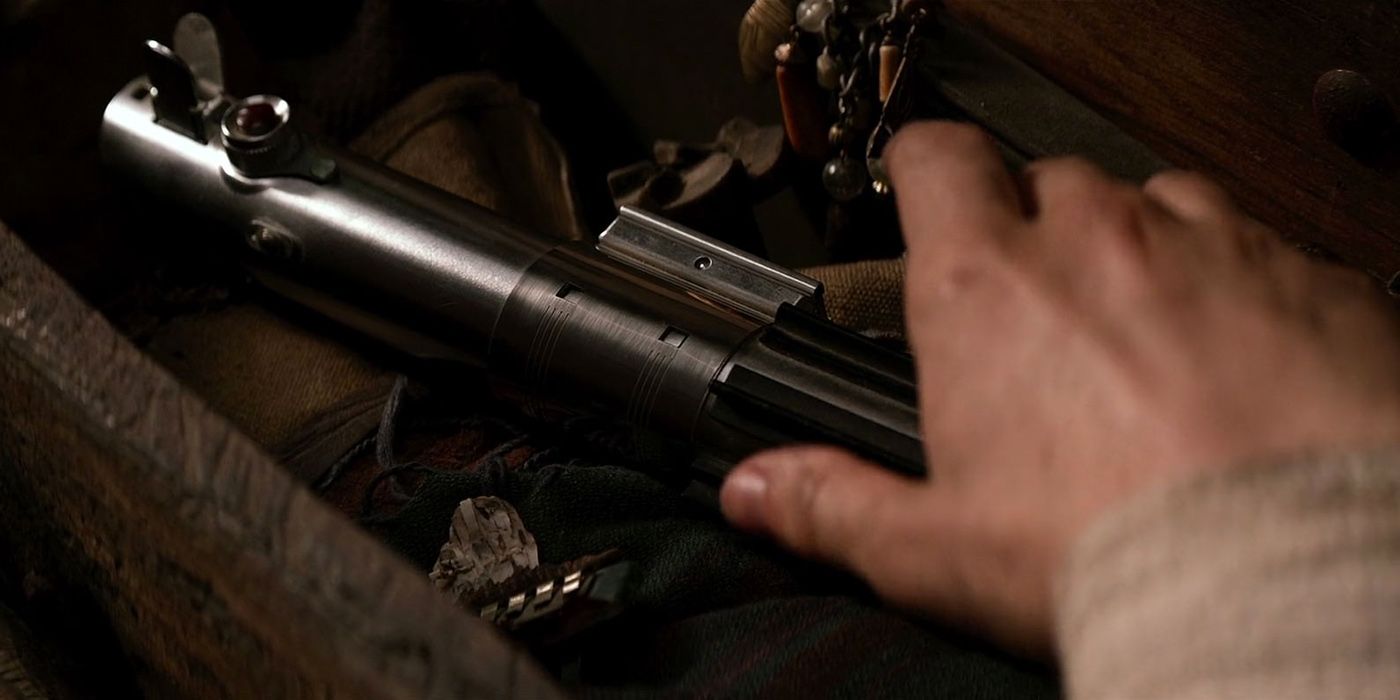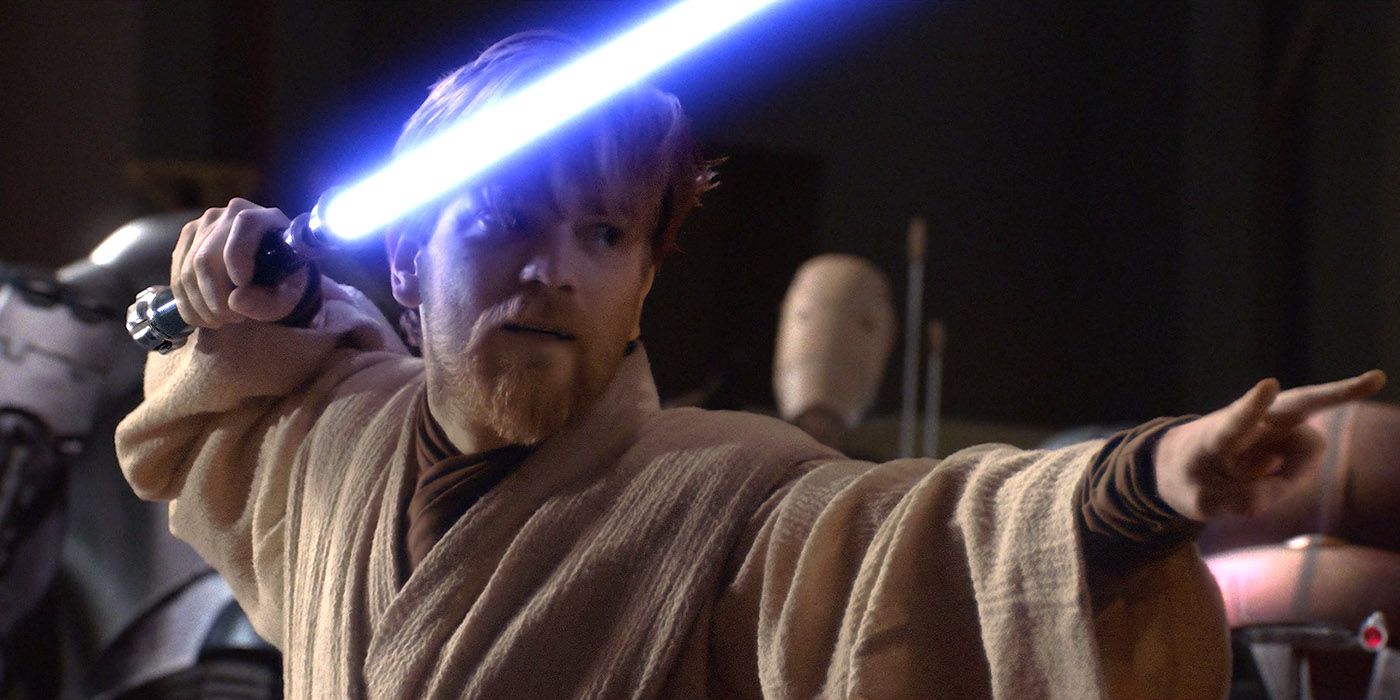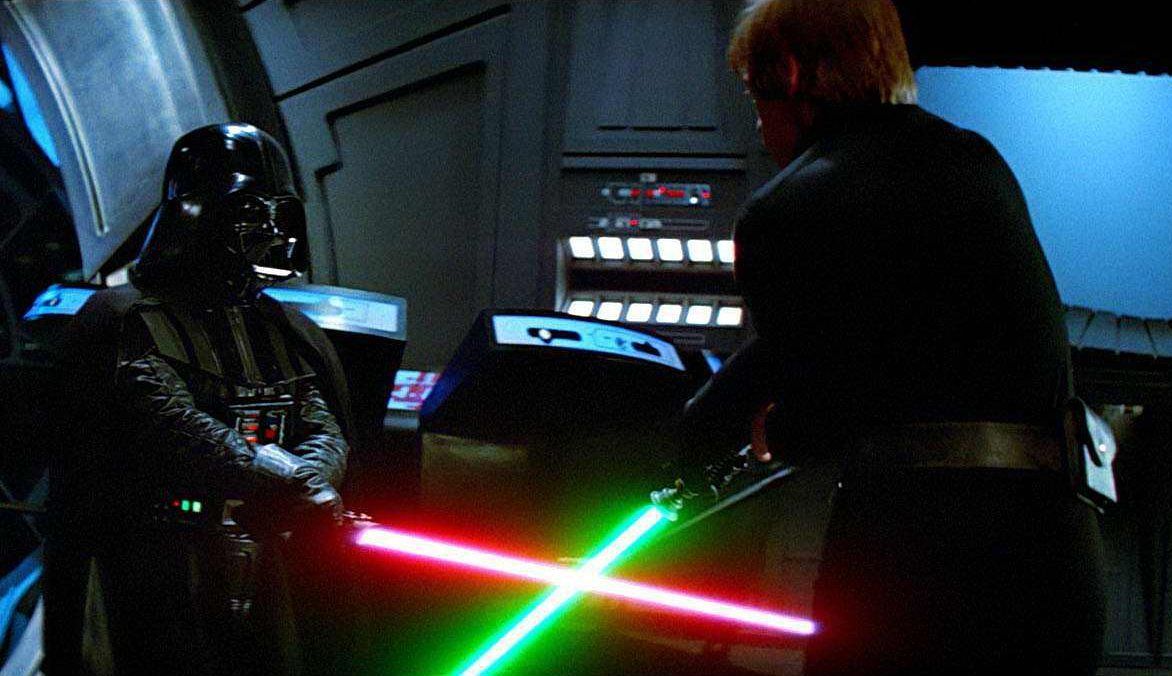When ranking the most iconic cinematic weapons of all time, the lightsabers seen in the Star Wars franchise arguably deserve the top spot. Ever since they first appeared in 1977’s Episode IV: A New Hope, these hi-tech blades – which paradoxically manage to harken back to a more romantic era – have captivated audience imaginations.
The movie magic responsible for the lightsaber has evolved considerably since it first debuted on screen. Where once the distinctive, colored glow of the laser sword was realized with painstaking, manually rotoscoped animation, this process is now achieved relatively simply via digital effects.
Likewise, the choreography used in the thrilling lightsaber duels that have become a signature element of the Star Wars series has also grown more sophisticated over time. Yet the overall look and sound of the lightsabers has ultimately changed very little over the past 41 years – a testament to the enduring appeal of Star Wars creator George Lucas’ initial concept.
As you might expect from a prop that can lay claim to four whole decades of filmmaking history, the lightsaber boasts a veritable treasure trove of behind-the-scenes trivia.
With this in mind, we’ve combed through all the available factoids to bring you our top 20 Crazy Behind-The-Scenes Facts About Lightsabers.
20. The First Lightsaber Props Were Incredibly Fragile
Within the Star Wars universe, the lightsaber is renowned for its ability to cut through virtually anything. Indeed, in the hands of a heroic Jedi Knight or a villainous Sith Lord, the lightsaber is effectively the ultimate weapon, capable of deflecting blaster fire, and – just as importantly – block another lightsaber.
Funnily enough, the real-world lightsaber props used on the first Star Wars film actually came up embarrassingly short in this last regard. That’s right: the original swords used in A New Hope were so fragile, that they almost always broke when they came into contact with each other.
Given that Alec Guinness’ wise mentor Obi-Wan Kenobi needed to face off against David Prowse’s dastardly Darth Vader, this obviously presented a problem for stunt coordinator Peter Diamond. After all, how could he choreograph a tense duel to the death, when the combatants couldn’t even bang their lightsaber props together? The solution Diamond devised was to have Guinness and Prowse stop their sword strokes short, so that the rods never made contact.
When seen on-screen, the close proximity of the lightsaber “blades” – coupled with optical effects embellishment – meant that audiences never suspected the visual trickery that had been committed. For sequels The Empire Strikes Back and Return of the Jedi, sturdier carbon fibre props would be constructed, but even these still had a frustrating tendency to break unexpectedly!
18. Lightsaber Training For The Force Awakens Took Three Months
The Force Awakens, the first episode in the recent trilogy of sequel Star Wars films, contains less lightsaber action than the other installments in the saga. Nevertheless, stars Daisy Ridley, John Boyega, and Adam Driver still underwent an intensive three month course to ensure their duelling skills were up to scratch.
In contrast to the elaborate, somewhat stylized choreography seen in the prequels, director JJ Abrams pushed for a more primal form of swordplay closer to that of the original trilogy. At the same time, all the characters – Rey, Finn, and Kylo Ren – had at least some combat experience, and this needed to be reflected in their lightsaber fighting styles.
Even though the trio of actors all trained for 12 weeks – starting out with bamboo swords, before moving on to proper lightsaber props – the techniques they learned were very different.
As Rey is someone more comfortable with a quarterstaff, Ridley’s form is noticeably the least polished on display.
On the other hand, Boyega’s Finn – as a highly trained former First Order stormtrooper – showcases a greater degree of familiarity with lightsaber-style combat. Then there’s Kylo Ren, who – by virtue of having actually been trained in lightsaber duelling – is the most technically proficient fighter in the film, as evidenced by the flourishes that punctuate his sword strokes.
19. Ewan McGregor And Samuel L. Jackson Kept Their Lightsabers
What’s the point of playing a Jedi Knight on screen and not getting to keep your lightsaber after? This was clearly the logic employed by actors Ewan McGregor and Samuel K. Jackson, who have both revealed they kept the props they wielded as Obi-Wan Kenobi and Mace Windu in the Star Wars prequels.
In Jackson’s case, it appears that that Academy Award-nominated star was gifted his lightsaber hilt by the props department (which they labelled with “BMF”, a nod to his role in Pulp Fiction). Certainly, Jackson has made no suggestion that there was anything that would have breached the moral codes of the Jedi Order concerning how this priceless artifact came into his possession.
McGregor is a whole other story, however. According to the Scottish thespian, his lightsaber was bestowed upon him– again, courtesy of the lovely folks in the props department – in a somewhat less “official” capacity.
Now, McGregor is known for his sense of humor, so it’s entirely possible he was only joking when he suggested that he effectively stole his lightsaber prop. This seems more than likely, given other cast members – including Liam Neeson, who portrayed Qui-Gon Jinn in The Phantom Menace – also mentioned receiving their lightsabers as a parting gift.
17. The Actors Struggled Not To Make Their Own Lightsaber Sounds
When the first lightsaber props were created for A New Hope, nobody – not even Star Wars creator George Lucas – knew exactly what they would sound like. It wasn’t until sound designer Ben Burtt created their now-unmistakable noise that it became inseparable from the ancient weapon’s equally recognizable aesthetic.
For this reason, there was very little risk of stars like Mark Hamill or Alec Guinness simulating the lightsaber sound effect on-set (and let’s be honest: there was never any risk where Guinness was concerned). Even by the time cameras rolled on The Empire Strikes Back and Return of the Jedi, none of the actors or stunt performers found themselves humming lightsaber noises during filming.
Fast forward 14 years to 1997, when shooting commenced on The Phantom Menace, and things had most definitely changed.
Unlike their predecessors, cast members Liam Neeson and Ewan McGregor found themselves unintentionally making the lightsaber’s by-now trademark noises orally - until they were asked to stop!
Neeson and McGregor weren’t the only new Star Wars recruits to indulge their inner sound engineer, either. Hayden Christensen – who stepped into the role of Anakin Skywalker/Darth Vader – similarly struggled not to produce lightsaber sound effects when swinging his prop in Attack of the Clones and Revenge of the Sith.
16. Kylo Ren’s Lightsaber LooksLike That For A Reason
When fans first glimpsed Kylo Ren’s lightsaber in the teaser trailer for The Force Awakens, the reaction to its design – which featured a crossguard – was mixed, to say the least. Although some viewers were intrigued by this new spin on an iconic weapon, others argued the placement of the additional “quillon” blades seemed likely to cause unintentional self-harm!
Luckily enough for audiences (not to mention Kylo Ren’s extremities), the crossguard lightsaber ultimately proved as effective – and safe to use – as its more traditional counterpart. Even better, its three unique, jagged-edged blades made for an arresting visual when seen in motion.
There was more behind the revamped lightsaber concept than mere innovation and visual appeal, however. According to concept designer Doug Chiang, Kylo’s claymore-like laser sword was intended to evoke weapons used by the “black knight” archetype from medieval lore.
This in turn would serve as visual shorthand, to quickly establish Ren as the obvious successor to previous franchise big bad (and black knight) Darth Vader in the minds of audiences. Chiang was so impressed with how effectively the crossguard lightsaber concept communicated this idea that he freely admits the practicality of its white-hot quillons instantly became an afterthought.
15. The Official Backstory Of Darth Vader’s Lightsaber Changed
When Disney acquired Lucasfilm back in 2012 and announced it would be continuing the Star Wars saga, the response from fans was generally enthusiastic. However, this excitement cooled somewhat following the subsequent news that decades of expanded universe continuity would be erased from the franchise’s canon as a result.
Although most followers of the series accepted this as a necessary step which allowed filmmakers to tell new stories unburdened by the events elaborated in countless novels, video games, and TV shows, a sizeable contingent were vocally miffed.
These fans protested that they had spent years investing in the rich history of the Star Wars universe not seen on film, and felt betrayed when their favorite adventures were relegated to “Legends” status. Despite this outcry, Lucasfilm pressed ahead with its decision to wipe the slate clean regardless, with much of the saga’s official backstory erased – only to be steadily replaced since.
This extends to the canonical origin of Darth Vader’s lightsaber, which underwent a radical re-imagining first in the novel Asoka, and then more fully in the Darth Vader comic book series.
It’s revealed that the Sith Lord stole his lightsaber from a fallen Jedi, before extracting and tainting its kyber crystal through a dark side ritual.
He then encased the now blood-red gem within a hilt he had crafted himself, which – as a darker version of the weapon he had carried as Anakin Skywalker – better suited his fighting style.
14. Ray Park Helped Design Darth Maul’s Double-Bladed Lightsaber
Although the double-bladed lightsaber first made its spectacular debut on the big screen in The Phantom Menace, the weapon wasn’t actually new to the Star Wars canon. As fans of the Tales of the Jedi comic book series – set thousands of years before the movies – will already know, this dual-edged implement was dreamt up much earlier.
For fans of the franchise unfamiliar with its expanded universe, this was the first time they had ever laid eyes on the weapon. As wielded by actor and stuntman Ray Park – who bought the demonic Darth Maul to life – the double-bladed lightsaber was a sight to behold, particularly given Park’s penchant for dramatically twirling it.
Funnily enough, these memorable flourishes almost didn’t make it into the movie, as comments by Park indicate the original saber design would have made them impossible to perform. In an interview following the release of the film, Park noted that the double-bladed lightsaber prop he first inspected had a hilt roughly the same size as its single-bladed counterpart.
This meant that the martial artist would have needed to hold it with his hands and wrists very close together – making even normal sword strokes difficult, let alone anything more flashy! Park raised his concerns with the concept artists and props team members involved, and the weapon’s design was tweaked to include a hilt that was now twice as long.
13. Almost Everybody Had Lightsabers In Early Drafts Of A New Hope
The script for what ultimately became Star Wars – Episode IV: A New Hope underwent heavy revisions prior to principal photography commencing in 1976. Virtually everything (and we really do mean everything) changed over the course of the four drafts penned by series creator George Lucas – and this included the lightsaber.
Not only was the iconic weapon known by a different name: “lazersword” – a variant of which would later crop up occasionally in the Star Wars mythos – but its use was far more widespread throughout Lucas’ fictional universe.
Whereas in the final screenplay, the lightsaber is identified as an ancient weapon used only by mystical Jedi Knights and Sith Lords, as initially conceived, pretty much everybody had one.
We’re not kidding: in the first few drafts, most Rebel soldiers and Imperial stormtroopers sported a lightsaber clipped to their belts!
Fortunately, Lucas wisely discarded this notion midway through the writing process, opting to make lightsabers a far less commonplace item in his galaxy far, far away. By doing so, he was able to re-cast the lightsaber as “an elegant weapon, for a more civilized age,” transforming it into a symbol of the near-extinct, noble Jedi Knights and the enlightened Republic they once protected.
12. The Lightsabers Used In The Phantom Menace Were Shrink-Wrapped
We’ve already covered how fragile the lightsaber props used in the production of the original Star Wars trilogy were, but in fairness, those used on the prequel trilogy weren’t a whole lot better. This wasn’t for want of trying, though: the props department swapped out the carbon fibre rods used previously with steel and aluminium upgrades.
Admittedly, these new lightsaber “blades” didn’t snap in half like their retro predecessors, but they did have a tendency to bend out of shape after heavy use. Despite being technically more durable, the updated props still required constant replacement.
Worse, during the filming of The Phantom Menace, stunt coordinator and swordmaster Nick Gillard noticed that when the props came into contact with each other, they gave off small particles of debris. To avoid a potential health and safety issue – without having to completely scrap the film’s existing inventory of lightsabers – the rods were coated with shrink-wrap.
You might think that these faulty props would have been retired when Attack of the Clones rolled around, but a better alternative wasn’t available. It wasn’t until Revenge of the Sith that the shrink-wrapped lightsabers would be superseded by non-bendy, non-flaky carbon fiber rods – this time laminated with glass and plastic.
Yet even these lightsabers weren’t entirely without a downside: unlike the earlier, flimsier props, these bad boys were capable of dishing out nasty bruises – and even left scars!
10. Mace Windu’s Purple Lightsaber Blade Was A Favor To Samuel L. Jackson
Samuel L. Jackson’s favorite color is purple – so much so that the actor frequently requests that the characters he plays somehow incorporate violet hues into their costumes or related props. It was no different when it came time for Jackson to finally ignite Mace Windu’s lightsaber on-screen in Attack of the Clones. He asked George Lucas to make the blade purple.
Interestingly, Lucas played coy when Jackson first made his request – promising the star only that he “might” get a purple lightsaber.
The reason why the director didn’t grant Jackson's wishes on the spot was simple: until that point, the canon lightsaber blade colors were blue, green, and red.
Sure, the expanded universe of novels, comic books, and video games had already introduced a veritable rainbow of lightsaber variants beyond the primary color spectrum preferred by Lucas. However, so far as the Star Wars movies – which constitute the final word on franchise continuity – were concerned, these hues didn’t really exist.
In the end, though, Lucas relented, and when Master Windu made his sword-swinging debut, he did so with a purple-bladed lightsaber in hand. There's an added bonus, too: in the film’s climactic – and crowded – battle scene, Jackson was easier to spot, owing to his saber’s unique tinge.
9. ILM Failed To Achieve The Lightsaber Glow Effect In-Camera
If we ever needed proof that we do not, in fact, live in the best of all possible worlds, just consider that modern science has thus far failed to produce a real-world lightsaber. True, many scientists (and fans) have created convincing facsimiles – some of which even possess at least some of the destructive power of their big screen equivalent.
But none of these properly replicate the lightsaber’s signature aesthetic, which makes sense, given its fictional specifications include a blade composed of pure, yet contained plasma. That hasn’t stopped people from trying to achieve the weapon’s otherworldly look for real – and that includes the special effects artists at Industrial Light & Magic!
During principal photography on the very first Star Wars film back in 1976, the pioneering effects team made a concerted effort to capture the lightsaber’s glow as an in-camera, practical effect. The gang at ILM covered the rods of the lightsaber props in the same reflective material used in road signs, and then added a motorized, high-speed rotating base, so that the reflected light would flicker.
The problem was, while this effect worked well when the lightsaber was oriented directly in-line with on-set lighting, whenever the “blade” moved outside this precise alignment, the glow disappeared. Given how crucial rapid movement is to lightsaber choreography, ILM soon abandoned this technique, and the lightsaber effects were added in post-production.
8. The Lightsaber Props Used In The Sequel Trilogy Actually Light Up
While ILM's admirable efforts to make light-up sabers may not have panned out – with lightsabers realized using traditional and digital rotoscoping techniques since – but that doesn’t mean luminescent lightsaber props haven’t been used since.
On the contrary, light-up versions were utilized briefly in Attack of the Clones, for an almost expressionistic sequence during the duel between Anakin Skywalker and Count Dooku. In this section of their showdown – which director George Lucas likened to a poem – the young Jedi and elder Sith Lord faced-off in complete darkness, illuminated only by their lightsabers.
Lucas primarily relied on close-ups of actors Hayden Christensen and Christopher Lee here, with the actors faces coming in and out of shadow as they moved their glowing “blades” overhead. However, the rest of this duel – as with virtually all lightsaber combat in the first six Star Wars movies – featured regular, non-radiant props.
On the other hand, the lightsabers used in recent sequels The Force Awakens and The Last Jedi – and presumably in the spinoff films as well – always light up.
Made possible by advances in practical effects technology, these impressively durable props not only cast interactive lighting on their surroundings, but provide a more immersive experience for the actors, as well.
7. Several Actors Didn’t Perform Their Own Lightsaber Duels
The majority of the actors cast as Force users have personally handled their own swordfighting. After all, it's their chance to wield pop culture’s greatest ever weapon, and be trained to look like an absolute boss doing it!
Even so, not every Star Wars thespian was up to the challenge of undertaking their own lightsaber duels. While almost every star from Mark Hamill through to Daisy Ridley can be seen displaying their own swordplay chops on screen, a few notable names can’t.
Amazingly – given he was the on-set performer for Darth Vader himself – David Prowse took part in very little lightsaber combat.
During his audition, the former weightlifting champion stretched the truth to breaking point when it came to his sword fighting experience, as he didn’t really have any. Although Prowse did his own duelling in A New Hope, for the more technically demanding choreography in The Empire Strikes Back and Return of the Jedi, uncredited Olympic fencer Bob Anderson wore shoe-lifts to double for the towering actor.
Then there are Christopher Lee and Ian McDiarmid, who – due to their advanced age – relied on younger stunt performers to manage their physically taxing combat scenes. McDiarmid and Lee – the latter of whom actually had extensive swordplay expertise – did participate in some of the less onerous duelling (predominantly in close-up). However, the lion’s share of Darth Sidious and Count Dooku’s lightsaber action involved stand-ins and CGI head replacement.
6. The Sound Effect Was Created (Partly) By Accident
If there’s anything as well-known as the visual of a brightly glowing lightsaber blade, it’s the unique sound it makes. Few sound effects in the history of filmmaking are as instantly recognizable by even the most casual of moviegoers than the noise of a lightsaber being thumbed to life.
You might think that such a brilliantly conceived bit of audio – an oddly melodious mixture of a steady hum and harsh buzz – was carefully thought out by sound designer Ben Burtt. You’d be totally wrong, though, as the genesis of the lightsaber’s sound has its roots largely in a serendipitous accident!
Burtt had already settled on the noise of an idling, worn-down film projector to provide the humming element he felt the weapon needed. He was struggling to find the right kind of buzzing sound to overlay with the projector’s hum, to give the laser swords the literal and figurative edge they needed.
It wasn’t until Burtt inadvertently recorded the interference from a TV set using a broken microphone that he stumbled upon the buzz he’d been searching for.
Burtt then combined these two audio elements – which he has remarked are both typically avoided by sound engineers – and the lightsaber sound effect was born.
5. Luke Skywalker’s Second Lightsaber Wasn't Supposed to Be Green
As soon as Luke Skywalker lost his lightsaber (along with his right hand!) during the climax of The Empire Strikes Back, it was readily apparent that the young Jedi needed a replacement. As many fans know, a scene depicting Luke putting the finishing touches on his new weapon were excised from Return of the Jedi, and when Luke’s lightsaber 2.0 does appear, it’s already ready to go.
This new laser sword also rocks a green blade, which was a first for the Star Wars franchise, with previous lightsabers having only featured a blue or red-tinged edge. Luke’s green lightsaber would not be the last of its kind seen in the saga, with characters like Yoda and Qui-Gon Jinn likewise favoring that color blade.
But what was the symbolic significance of Luke’s lightsaber shifting along the spectrum? Was it intended as an underlying comment about our hero’s own personal evolution? Well, as it turns out, the rationale behind the change was purely driven by more prosaic aesthetic considerations, instead.
Originally, Luke’s second lightsaber was going to be blue, just like the weapon he had inherited from his father.
Early trailers and promotional artwork even depict Luke wielding an azure blade. However it soon became apparent to director Richard Marquand and executive producer George Lucas that a blue lightsaber didn’t read very well against the equally-blue sky present during the opening skiff battle. A replacement color was clearly needed to provide greater contrast, and Lucas and Marquand settled on the now-conventional green.
11. The Original Lightsaber Hilts Were Made From Retro Camera Flash Attachments
Ironically for such a futuristic-looking weapon, the real-world origin of the first lightsaber hilt props is decidedly old-school. Just how retro are we talking? Well, the hilts constructed for A New Hope were actually re-purposed flash attachments for old-timey cameras.
That’s right: the coolest swords in cinematic history were created using parts from vintage cameras commonly associated with press photographers from the 1930s and 40s.
In most cases, all that set decorator Roger Christian did – after cannily realizing the attachments would make the perfect starting point – was to glue on hi-tech looking “greeblies.”
These included garden-variety items like cabinet T-track for the handle grips, bubble strip from a contemporary calculator and D-rings, so that the lightsaber hilts could be attached to the actors’ belts.
Of the three lightsaber props fashioned for the original Star Wars outing, the hilts used by Luke Skywalker and Darth Vader were comparatively simple affairs. Luke wielded a Graflex camera side-flash attachment, while Vader carried a Micro Precision Products attachment – both with only minor cosmetic adjustments.
On the other hand, the lightsaber belonging to Obi-Wan Kenobi took considerably more elbow grease to finish. All told, Kenobi’s lightsaber hilt comprised components from an Armitage Shanks Starlite tap head, a Browning ANM2 machine gun booster, a WWI No.3 Mk.1 British Rifle Grenade, and a Rolls-Royce Derwent Mk.8/Mk.9 Jet Engine Balance Pipe!
4. Lightsaber Combat In The Prequels Included Tree-Chopping And Tennis Techniques
When it came time to develop the lightsaber fighting styles seen in the Star Wars prequels, director George Lucas’ brief to swordmaster and stunt coordinator Nick Gillard was simple. He wanted Gillard to come up with a more energized version of the choreography seen in the original trilogy, to properly portray Jedi in their prime during the heyday of the Jedi Order.
Based on fan reaction to the lightsaber combat on display in The Phantom Menace, Attack of the Clones and Revenge of the Sith, it’s fair to say Gillard was wildly successful. As re-envisioned by Gillard, Jedi Knights – and their nefarious Sith Lord opponents – were more than just accomplished swordsmen and women. They were akin to a force of nature, moving at lightning speed and dispatching multiple foes with dazzling skill and acrobatic grace.
In order to develop the choreography used across all three films, Gillard drew on a variety of real-world martial arts, as well as some more unlikely sources of inspiration. These included activities that incorporate similar, swinging motions such as tree-chopping and tennis!
It may sound a little crazy, but the logic behind it is actually very sound. Gillard reasoned that for the Jedi to feasibly use a short-range weapon in a world filled with long-ranged blasters, they would need to be proficient in just about every edge-weapon fighting style (and raquet-based sport) that ever existed.
3. The Force Awakens Originally Opened On A Lightsaber (And Hand) Floating In Space
Director JJ Abrams and his cast and crew did a commendable job of keeping most of The Force Awakens’ plot details under wraps prior to its release in cinemas. That said, as with any film, spoilers did occasionally find their way onto the internet – with the most intriguing related to the movie’s opening scene.
According to the rumor mill, immediately following the traditional opening crawl of expository yellow text, the camera would tilt down to reveal a familiar-looking lightsaber floating in space. This would be none other than the weapon originally belonging to Anakin Skywalker and passed on to his son Luke – believed lost forever when Luke was relieved of his right hand in The Empire Strikes Back.
Somewhat hilariously, Luke’s severed appendage is still clinging on to the lightsaber as it drifts through the endless void. This frankly remarkable grip is only broken when both hilt and hand enter the orbit of a nearby planet, with only the hilt withstanding re-entry.
When The Force Awakens finally hit theatres, this scene was nowhere to be found, leading some to suspect it was a hoax. Not so, if comments by Luke Skywalker himself Mark Hamill – which suggest that this alternative introduction was at one point on the cards – are to be taken seriously.
In addition to the previously mentioned unintentional hilarity factor, the scene doesn’t make much sense. Think about it: how did the lightsaber wind up in space, when the last time we saw it, it was plummeting towards the surface of Bespin?
2. George Lucas Originally Banned One-Handed Lightsaber Moves
A major part of Star Wars creator George Lucas’ initial conception of the lightsaber was that – despite being comprised predominantly of pure energy – it was surprisingly hefty. The idea was that this would communicate the raw power of the weapon, both literally and symbolically.
As such, Lucas made a big deal about the actors handling the lightsaber props essentially like heavy medieval broadswords or Japanese katana, with an emphasis on a two-handed grip at all times. He was very adamant about this at first, but over time his severe stance lessened, and one-handed sword strokes began to creep into the choreography.
Lucas rationalized this by deciding that single-handed swordplay could be used to suggest the greater skill and control of the combatants involved. This is why swordmaster and stunt coordinator Nick Gillard was given such free rein when it came to one-handed lightsabre techniques in the prequel trilogy: the Jedi and Sith portrayed here are at the peak of their powers.
Of course, as with more than a few of Lucas’ pronouncements, this explanation doesn’t quite stack up when applied to the original films. Take The Empire Strikes Back, where Jedi-in-training Luke Skywalker confronts the cyborg Darth Vader – who by Lucas’ own admission, is a shell of his former self.
As described above, neither combatant should be capable of busting out top-shelf lightsaber moves. Yet both are seen effortlessly adopting a one-handed grip on their laser swords, almost from the get-go!
1. Darth Vader’s Lightsaber Prop Was Lost Prior To Filming Return Of The Jedi
Darth Vader is arguably the character most synonymous with the Star Wars franchise. Rightly regarded as one of the very best villains cinema has ever produced, everything about the Sith Lord – from his intimidating frame to his “space samurai” outfit and perpetual wheeze – screams “icon,"
From the moment Vader appeared on screen in A New Hope – almost immediately choking a Rebel soldie, of course – this baddie instantly left his mark on the collective pop culture consciousness.
Following the release of The Empire Strikes Back – which saw our guy graduate from supporting villain to proper main antagonist status – Vader’s popularity only continued to surge. Under normal circumstances, such a high degree of public adoration for a character would ensure that all of the costumes and props related to them were treated as treasured, closely guarded items.
This definitely wasn’t the case when it came to Vader, as his lightsaber somehow went missing right before the cameras were set to roll on Return of the Jedi! This necessitated the speedy fabrication of a new prop to replace it, using one of Luke’s old lightsabers as its base. As a result, more eagle-eyed fans have identified several differences between Vader’s hilt in the final film in the trilogy compared to the first.
---
Did we miss any other behind-the-scenes lightsaber facts from Star Wars? Let us know in the comments!

